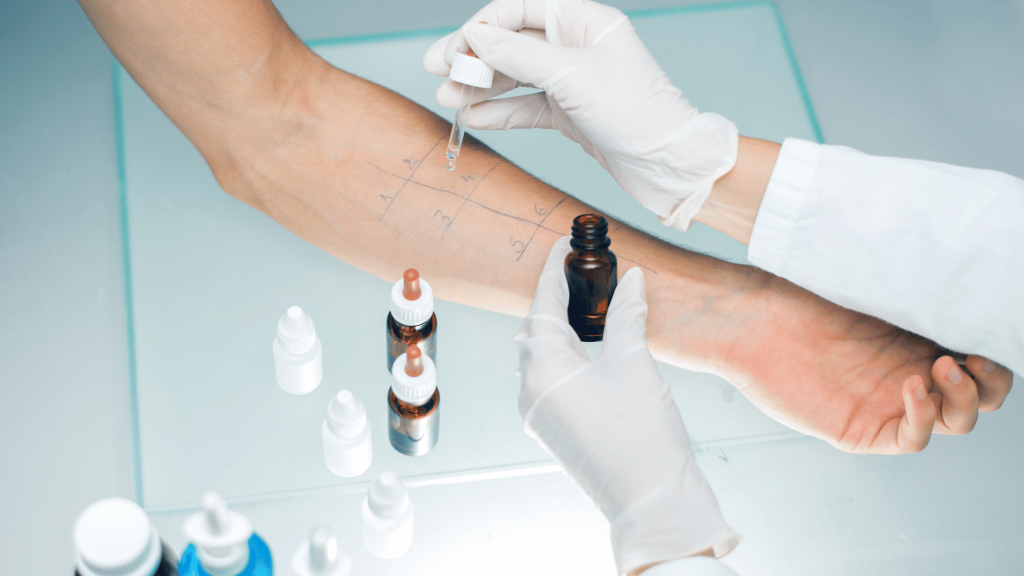
A patch test is a critical diagnostic method used by practitioners to identify potential allergies or sensitivities to substances applied to the skin. By performing a patch test, healthcare providers can prevent adverse reactions and ensure a safe and effective treatment experience. In this blog post, we’ll explore various treatments that typically require a patch test, highlighting the importance of this essential step in your treatment journey.
Hair Colouring
Hair dyes contain various chemicals that can cause an allergic reaction in some individuals. To avoid this, a patch test is often performed before hair colouring services. By applying a small amount of the hair dye to the skin, usually behind the ear or on the inner arm, a practitioner can determine whether the client will experience an adverse reaction to the product.
Permanent Makeup
Permanent makeup procedures, such as tattooing, microblading, or other pigment implantation techniques, involve the insertion of pigment into the skin. As these treatments have a lasting effect, it’s crucial to perform a patch test to ensure the client is not allergic or sensitive to the pigments used.
Eyelash and Eyebrow Tinting
Eyelash and eyebrow tinting treatments involve applying dye to the hairs to darken and enhance their appearance. A patch test is typically conducted before these treatments to check for any sensitivity or allergies to the dye being used.
Henna Tattoos
While henna tattoos are temporary, the ingredients in the henna paste can cause reactions in some individuals. A patch test is performed to determine if the client will experience any adverse effects from the henna ingredients.
Chemical Peels
Chemical peels involve the application of an acid or enzyme solution to the skin to promote exfoliation and rejuvenation. A patch test is essential to ensure the client’s skin can tolerate the specific solution used in the peel, preventing any undesirable side effects or complications.
Laser Hair Removal
Although not directly involving a product application, a patch test may be performed before laser hair removal treatments. This test helps assess the client’s skin response to the laser treatment and enables the practitioner to determine the appropriate settings for the client’s skin type.
Microneedling
Microneedling treatments involve puncturing the skin with tiny needles to promote collagen production and improve the skin’s overall appearance. A patch test is often performed to evaluate the client’s reaction to the topical numbing agent or any serums applied during the treatment, ensuring a safe and comfortable experience.

Facial Treatments
Various facial treatments involve the application of products, such as cleansers, exfoliants, or masks, to the skin. A patch test is typically conducted before these treatments to test for sensitivities or allergies to specific products or ingredients used in the treatment.
Allergy Testing
Patch tests are an essential part of allergy testing, which involves determining a client’s reaction to potential allergens, such as fragrances, preservatives, or specific ingredients in skincare products. By applying a small amount of the suspected allergen to the skin, a practitioner can identify whether the client will experience an allergic reaction.
The Importance of Patch Tests
Patch tests play a vital role in ensuring client safety and comfort during various treatments. If you’re considering any of the treatments mentioned above, it’s essential to discuss patch testing with your practitioner. Furthermore, always inform your healthcare provider of any known allergies or sensitivities before receiving treatment.
In Conclusion
Understanding the treatments that require a patch test is crucial for both clients and practitioners. By conducting patch tests for the appropriate treatments, practitioners can ensure a safe and effective treatment experience, while clients can have peace of mind knowing that their safety and well-being are prioritised. By being aware of the importance of patch tests, you can take the necessary precautions to prevent adverse reactions and enjoy a more satisfying treatment outcome.
As a client, always choose a qualified and experienced practitioner for any treatments requiring a patch test. Do your research, read reviews from previous clients, and ask for recommendations from friends or family members. A reputable practitioner will be knowledgeable about patch testing and will adhere to local regulations and best practices.
In addition, be proactive in your communication with your healthcare provider. Discuss your medical history, any previous reactions to treatments, and your expectations for the treatment you’re considering. Open communication will enable your practitioner to tailor the treatment plan to your needs, ensuring a positive and safe experience.
Ultimately, patch tests are a critical aspect of many treatments, ensuring the safety and well-being of clients. By being aware of which treatments require a patch test and the importance of this diagnostic step, you can make informed decisions about your treatment journey and enjoy the best possible results.